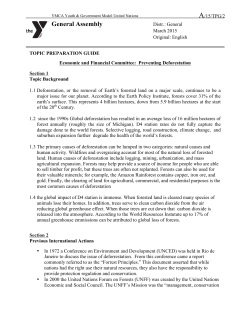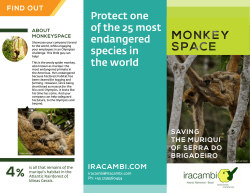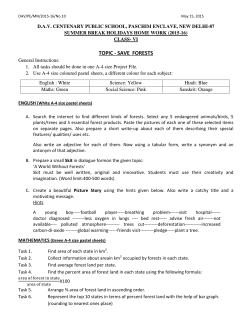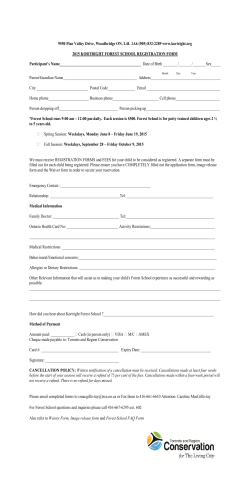
Actions to Save the World`s Trees
Actions to Save the World’s Trees BY RICK DOCKSAI Halting deforestation will require the cooperation and coordination of the world’s governments, businesses, and civil society. Networks of activists are now slowing the destruction of forest areas, promoting sustainable farming and ranching practices, and restoring forest cover wherever possible. These efforts will not only benefit both human and forest well-being, but also help mitigate climate change. PHOTOS: NASA AND (INSET) LANTHILDA / DREAMSTIME.COM A S THE EFFECTS OF CLIMATE CHANGE ARE FELT ACROSS THE globe, Earth-conscious innovators pursue a list of technological wonders to offset our species’ carbon footprint: geoengineering, alternative energy, hybrid vehicles, etc. Each techno-fix shows some potential for success, and each might have a role to play in years to come. But let’s not forget one design feat that is fully within our means to deploy here and now: more trees. The efforts of governments, businesses, and nonprofit organizations everywhere have begun to curb deforestation and bring some hitherto-destroyed forest areas back to life. As their efforts gain ground—and they can, with more support from citizens and communities worldwide—those trees will naturally reduce atmospheric carbon and boost both the planet’s health and ours. The satellite imagery above shows vegetation across the globe. Dark green indicates forests. Inset photo: Swaths of rain forest in Brazil’s Panatanal region have been cut for farmland. www.wfs.org • THE FUTURIST September-October 2013 45 © 2013 World Future Society • 7910 Woodmont Avenue, Suite 450, Bethesda, MD 20814, U.S.A. • All rights reserved. Global Forest Health Today Brazil hit a milestone in 2012: Forest loss that year, at 4,500 square kilometers, was the lowest since 1988—and a steep drop-off from the 27,000 square kilometers of forest cover that the country lost in 2004. Depletion of the Amazon’s forest cover had been widespread in the twentieth century as Brazil developed economically: The cleared forests made way for logging, cattle ranching, and farming of cash crops such as soybeans. Then, starting in the late 1980s, the government initiated measures to halt deforestation; more recently, it committed to bring- can lead to improvements in farming and forest management.” Concerns over Brazil’s Amazon rain forests, which shrank by about 18% in the last century due to deforestation, have been growing steadily in Brazil and worldwide: The Amazon is home to between one-third and one-half of the world’s remaining tropical forest land. Another large share of world rainforest cover lies in Africa. Unfortunately it is in even more trouble. Impoverished African families and communities struggle to scratch out livelihoods from the land, as they have for generations, by foraging for wood to use as fuel and by clearing BIDOUZE STÉPHANIE / DREAMSTIME.COM Forests that disappear can sometimes be brought back, through community tree plantings, or “reforestation” efforts. This Thai villager has just planted a new mangrove tree in a forest in Satun, Thailand. ing deforestation down to less than a fifth of the 2004 level by 2020. As of 2013, it is almost 80% there. Conservationists keep pushing for the forests’ viability over the long term. Deforestation continues, even if it is drastically reduced and no longer has the tacit acceptance of government and business leaders. “The situation is not stable yet. We have to consider we have a lot of achievements and good results, but we still have high rates of deforestation,” says Luis Fernando Guedes Pinto, certification manager for IMAFLORA, a Brazilian environmental conservation nonprofit that partners with the Rainforest Alliance. “We still need many interventions that 46 THE FUTURIST forests to make way for small-scale farming. While Africans’ efforts to survive are indisputably justified, the toll on the continent’s natural resources is steep: Forests in Africa are being cleared nearly three times faster than the global average, according to the Forest Philanthropy Action Network (FPAN). Ghana and Nigeria each have only around 5% of the forest cover that they had 75 years ago. Particularly severe deforestation is also taking place in Liberia, Kenya, Uganda, and areas of Cameroon, Sudan, and Ethiopia. FPAN names small-scale agriculture as a principal contributing cause. Fuel needs are another cause, September-October 2013 • www.wfs.org since communities comb their neighboring forests for wood chips and branches that they can feed to their wood-burning stoves. According to the UN’s Food and Agriculture Organization, fuel accounts for about 80% of the wood that African consumers use every year. Worldwide, 32 million acres of forests—an area almost the size of Nicaragua—are cleared each year. This is an improvement over the rates of two decades ago: The net rate for global deforestation totaled 0.14% from 2005 to 2010, versus 0.20% from 1990 to 2000. Moreover, domestic forest acreage either held steady or grew during the 2005-2010 time frame in 80 countries, including China, Costa Rica, India, the Philippines, Russia, the United States, and Uruguay. Nevertheless, reduced global deforestation is still deforestation. While the world’s forests are shrinking more slowly, they are shrinking. And as they do, the Earth’s capacity for capturing and storing planetwarming carbon dioxide shrinks along with it. At the present rates, deforestation accounts for 10%–15% of global greenhouse gas emissions, according to FPAN, since every tree, when chopped, releases its store of carbon dioxide. As a comparison, guess how much carbon-dioxide generation traceable to human activity comes just from automobile traffic. According to the World Resources Institute, it’s around 15%. Certifying Forest-Friendly Farm Practices Examples of remediation efforts are all around us. Governments, businesses, and nonprofit groups are teaming up to stop the human activities that are contributing to forest destruction and to bring back lost forest cover wherever possible. It is doable, but it takes a concerted effort, constant commitment by all to keep improving the methods and results. “If we just stop here and make everything ‘sustainable at today’s levels,’ that’s not really sustainable. We need to think differently. Simply just being a bit more sustainable than we are now, I don’t think is going to cut it,” said Ian Cheshire, director of Kingfisher, a home- i m p ro v e m e n t re t a i l c o m p a n y. Cheshire spoke during the May 15, 2013, workshop “Greenovation: How the Certification and Sustainability Sectors Are Reinventing the Future of Their Industries,” which was convened in New York City by the nonprofit Rainforest Alliance. Kingfisher is one of the millions of companies, farms, and ranches to whom the Rainforest Alliance has been administering training, certification, and continuing oversight and support in making their business practices as environmentally friendly as possible. The Rainforest Alliance formed in the late 1980s, when global awareness of the plight of tropical forests was on the rise. Bucking the stereotype of environmental activism locked in a war of wills against business interests, the organization was an early proponent of “smart wood”—i.e., procuring timber at moderate rates and with due concern for the forests’ health—and market-driven forestry certification, by which businesses could choose to learn environmentally healthy practices and receive recognition when they make those practices standard throughout their operations. The Rainforest Alliance works with the Sustainability Action Network (SAN), an organization whose activities include the development of standards of sustainable farming and ranching. The Alliance teaches these standards to participating farmers and ranchers and then follows up with them to make sure that they are making progress on their farms and ranches toward meeting the standards. Those who do meet the standards are officially “certified” and get to post a Rainforest Alliance seal of approval on their products’ packaging. “The whole point of certification is to give people directions or goals and to ensure that they’re moving in those directions, and to use the certifications to communicate to the world that they’re continuing to improve,” says Karen Lewotsky, manager of sustainable agriculture at the Rainforest Alliance. The Alliance has worked with more than 11 million producers since its founding. As of March 2013, it has certified 174 million acres worldwide—added up, a land mass almost the size of Chile. Rainforest Alliance– certified farms now produce 10.2% of the world’s cocoa, 11.2% of its tea, and 15% of its bananas. Its share of the world’s coffee is smaller, at 4.6%, but the potential for growth is certainly there, given growing publicity. Kenco, Kraft, and McDonald’s all served Rainforest Alliance–certified coffee at the 2012 Olympic Games in London. The standards include dozens of individual rules that cover the full range of environmental and human health, including requiring crop rotation, restrictive pesticide and fertilizer usage, the maintenance of minimum distances between crops, and the construction of protective barriers along neighboring rivers and other waterways. There are also guidelines for humane treatment of the farm animals and adequate pay, benefits, and labor conditions for all farm workers. Certification also requires certain quantities of crops to be grown under the shade of trees. The bar is higher for coffee and cocoa farmers, who must keep at least 40% of their crops under the shade of forest cover. This rule isn’t in place just so that there will be more trees. Shadegrown coffee and cocoa plants require less water and fertilizer, in addition to producing more stable yields year-to-year. Also, the trees’ roots act as a buffer protecting waterways from harmful runoff and land erosion. The soil and any accompanying manure and agrochemicals cling to the roots instead of washing into nearby lakes and streams. The water ecosystems and, of course, the forests that feed off of them are all healthier as a result. How Healthier Forests Improve Agriculture These forest-cover stipulations make economic as well as environmental sense. The coffee and cocoa farmers attest that the shade cover RAINFOREST ALLIANCE A coffee farmer on a Rainforest Alliance– certified farm in Vietnam’s Central Highlands region weeds by hand instead of using potentially harmful herbicides, and then uses the organic material he gathers for a compost pile. The standards additionally include a stipulation that the farmers and ranchers set aside portions of their land as protected reserves on which no development will take place. As of 2013, certified farms and ranches across the globe have designated 28 million acres of land as protected reserves. www.wfs.org • improves the flavor of their coffee crops. Since enough consumers seem to agree, the certified farmers earn a premium for their shaded coffee once it sells. The certification standards raise productivity, too: In Côte d’Ivoire, home to 40% of the world’s cocoa supply, certified cocoa farms grow THE FUTURIST September-October 2013 47 508 pounds of cocoa per acre, compared with an average of 294 on the noncertified farms. Financial gains from certification extend to numerous other crops, as well. Overall, Ivoirians whose farms are certified are earning $161 per acre, compared with $45 per acre for noncertified farms. In March 2012, the Fazendas São Marcelo Ltda. chain of ranches in Brazil became the first-ever beef producers to gain Rainforest Alliance certification. The chain’s four ranches, enjoy shade on hot days just as people do, explains Lewotsky. That makes a difference in overall cattle growth and the quality of the beef. Building embankments along the waterways is yet another sustainable practice that the ranches have put in place. The ranchers plant trees near the shores to hold off erosion, and they build rock paths near the water along which the cows may walk. As Lewotsky points out, the rock paths prevent the cows from plodding around in the mud and inadver- RAINFOREST ALLIANCE Cattle graze amid overhead trees, whose shade cover makes the cows more comfortable and benefits the surrounding ecosystem. located in the Mato Grosso state of western Brazil and holding 60,000 cattle on 79,000 acres of farmland, has 32,000 acres of rain-forest land set aside as a buffer zone between the pastures and the forests. As a bonus to the environment, that reserve is also a popular shelter area for migrating birds and other wildlife. The cows get a natural feed that reduces methane emissions—no small perk, given that livestock are the source of 18% of the world’s greenhouse-gas emissions, according to the Rainforest Alliance. And their pastures are dotted with groves of trees, which give the cows shade cover from heat, wind, and rain. The green cover compensates for some of the forest land that the ranchers initially had to clear. It also makes the cows happier and healthier. Cows 48 THE FUTURIST tently dislodging more of its dirt (and their own manure) into the adjacent water. In the year since the Fazendas group attained its certification, the Rainforest Alliance and partner nonprofits have been disseminating these same sustainable ranching methods to other cattle growers far and wide. Thus, more ranches elsewhere have also attained certification. And in March 2013, Gucci unveiled a new line of bags, all made using leather from Rainforest Alliance–certified ranches. Sustainability Sells That McDonald’s, Kraft, and Gucci would all go through the trouble of adding certified-sustainable products to their inventories really isn’t a September-October 2013 • www.wfs.org surprise. Demand for environmentally friendly products is growing among the world’s consumers. If a product is verifiably green, then a large number of potential buyers will choose it over a competitor product that isn’t, all other factors being equal. A 2012 poll from Harris Interactive found that 79% of Americans actively search for green products, and 31% say they would pay extra for products that were more environmentally sustainable than other products (versus 28% who said so in 2010). The number is higher, 45%, among 18- to 24-year-olds. A full quarter of U.S. adults in the survey identified environmental issues as “extremely” important. “Ultimately there is a certain level of profitability, and you’ve got buyers all over the world who are concerned about this,” says Lewotsky. “Buyers want that reassurance. They’re going into the store and saying ‘What am I willing to pay for?’” This same environmental awareness is likewise gaining traction among companies’ shareholders, who are becoming more likely to expect business operations to live up to standards of sustainability. Thus, the producers feel an incentive from above to replace environmentally harmful practices with more benign ones, and the retailers come under pressure to line their store shelves with green products. “There is an expectation. You look at almost any large organization these days you’re going to come across some sort of sustainability manager. They’re looking at how to increase sustainability in the company,” Lewotsky says. “That’s something people will seek out and will talk about. And you can do it at a lot of different places in the supply chain.” The process requires multiple levels of buy-in, however. “Certification is a great vehicle for bringing some of the messages across. But unless all of the stakeholders, particularly the government and industry, get together and get this done, we will only make a small dent on the issue of sustainability, unfortunately,” according to Daudi Lelijveld, vice president of sustain Businesses Helping Businesses Be More Sustainable T h e t e a c o m p a n y Te t l e y latched onto sustainable growing and manufacturing in the early 1990s, and by the middle of the decade it had instituted resource-saving and ecosystempreserving measures within every step of its supply chain. Its leadership then decided to help other businesses to do the same. So it reached out to the multinational Unilever with a proposal that the two companies collaborate to monitor each other ’s supply chains. Unilever agreed and, in 1997, cofounded with Tetley the Ethical Tea Partnership. The initiative now has 50 tea makers under its umbrella. Each one commits to having teams of monitors regularly visit its tea plantations to ensure that the laborers work under fair labor condi- ability at the Alliance-certified cocoa grower Barry Callebaut, which runs numerous sustainable cocoa farms in Côte d’Ivoire. Brazil is arguably a great test case in what can happen when stakeholders from many sectors work together. Starting in the 1980s, Brazilian government leaders were well aware of the slow death that the Amazon was suffering from human activity. The officials went to work cordoning off swaths of rain forest as national parks and enacting new legal curbs on forest destruction. In the last few years, the government has utilized satellite technology to step up these protective measures. Brazil’s space agency deployed satellites to gather data on forest cover all across the country, and the national environmental agency studied the satellite photos to spot signs of troubled areas and organize teams of on-the-ground monitors to visit the sites. “Brazil has had an outstanding space program for three decades, and so they’re using that technology to better monitor deforestation tions and that standards for water use, energy consumption, chemical usage, waste management, ecosystem conservation, and other environmental indicators are all adequate. It’s not often that one hears of a business helping another business to improve its production methods, especially when both businesses are competitors—Unilever’s product line includes tea and other beverages. But Tetley’s leadership was willing to think beyond sheer competitive advantage, and the whole industry is arguably better for it. Tetley merged with Tata in 2000, and so its operations are now within the Rainforest Alliance network of certified businesses. Plenty of other businesses within this network share the Tetley executives’ throughout the region,” says Gary Hartshorn, president and CEO of the World Forestry Center. Government officials have seized 2,000 square meters of illegally cut timber in the past year alone. The confiscated wood gets sold at auctions, with the proceeds directed to environmental conservation programs. Meanwhile, IMAFLORA and other nonprofit groups have been teaching communities about the benefits of forest conservation and methods that the communities can employ to farm the land more sustainably. In meeting the nation’s goal of slowing deforestation, Brazilian leaders credit the combined efforts of public–private monitoring and corrective action with making a big difference in a relatively short time frame. Meeting Africa’s Wood Demands Communities throughout Africa value their forests, but they also need to survive. Lack of infrastrucwww.wfs.org • belief in the value of helping other businesses, even rival businesses, on sustainability. Kingfisher, for example, is leading open-source dialogues with other companies on developing performance indicators and recommendations for businesses to improve their impacts on the environment. It will disseminate the finalized methods over the next few years. “We cannot rely on the consumer to lead the change. It’s up to us to try and make a difference. It’s up to us to learn from each other,” said Chris Coates, director of sales for IndoTeak Design, a Rainforest Alliance-certified maker of teak wood products, during the May 2013 Greenovation workshop. —Rick Docksai ture and lack of money leave too many Africans having to choose between either chopping down trees and overhunting, or not having food and fuel. If they and the rest of the world community want to save Africa’s forests, then economic improvement will have to take place, Hartshorn says. “Not knowing where the next meal is coming from, it’s understandable they might be running snares or hunting for bush meat,” he says. “It’s pretty fundamental that you have socioeconomic development that allows people to think about tomorrow and not just about today.” Africa’s forests face continued assaults from logging and the collection of wood for fuel. But FPAN sees great potential for relief from another form of sustainable industry: wood plantations. The planters maintain set plots of trees that they replenish with new seedlings continuously, ensuring steady incomes for themselves and consistent supplies of wood for the local markets. Plantations produce substantially THE FUTURIST September-October 2013 49 more wood per acre than do natural forests. Domestic timber plantations are a sizable industry in certain parts of the tropics, though there are relatively few in Africa. FPAN projects that Africa could establish enough domestic timber plantations to supply wood fuels to all Africans who needed them, and that the amount of required land would be a mere 20% of the total square mileage of forests that are now being exploited. Helping African households obtain fuel-efficient stoves would be another huge improvement, according to FPAN. The organization estimates that, if Kenya’s 6 million rural households were outfitted with fuel- parts of the globe, he notes. So private donors should consider offering financial support to help cover such subsidies, expand the distribution systems for fuels, and, in addition, help shore up individual republics’ struggling environmental protection agencies. World government leaders who want to help, meanwhile, might consider Reducing Emissions from Deforestation and Forest Degradation (REDD) agreements: i.e., paying developing countries not to clear their threatened forests. The receiving countries use the money for creating forest reserves, promoting land conservation within the communities GOZZOLI / DREAMSTIME At this tree plantation, young saplings are raised in rows within protective netting. Once they mature, they will replace the trees that loggers have previously cut. efficient stoves, the country’s annual fuel wood consumption would be reduced by 50%. This would translate to 8.4 million fewer tons of carbon dioxide being released into the atmosphere per year. Here, too, government cooperation with nonprofits can help, in this case for guiding the placement of new plantations and enacting incentives to spur consumer demand. B ernard Mercer, co-founder of FPAN, favors more plantations established close to urban centers and governmental subsidies to incentivize buying wood from plantations. Most of Africa’s governments are considerably weaker and more cashpoor than their counterparts in other 50 THE FUTURIST that live on forested land, enacting and enforcing limits on logging, and restoring forest cover. The World Bank oversees several REDD programs, while the UN’s REDD Programme, founded in 2008, now provides funds to the forest-conservation programs of 16 partner countries, including Bolivia, the Democratic Republic of the Congo, Indonesia, the Philippines, Tanzania, and Zambia. UN delegates from rain forest nations had been arguing for including REDD in climate-change-reduction initiatives precisely because of deforestation’s role in raising greenhouse-gas emissions. FPAN agrees and hopes to see REDD put in place in every September-October 2013 • www.wfs.org country throughout Africa. But REDD programs are far from perfect. First, solid data on the partner countries’ present deforestation and their conservation efforts are sparse. It is an open debate as to how much good REDD programs have achieved for the targeted forest regions so far. Additionally, many African countries that are not yet REDD program partners might have great difficulty qualifying, due to inadequate governance, underdeveloped infrastructure, and poor public-sector and private-sector transparency. Also, there is too little data on forest degradation—i.e., forest environments not necessarily cleared in full, but critically damaged from being stripped of wood for fuel or due to wildlife populations being depleted by poachers, for instance. According to Mercer, a REDD program will be more effective when there are private-sector initiatives developing profitable REDD projects. Cap-and-trade mechanisms that would let businesses purchase and sell “forest-carbon credits” is one solution that Mercer strongly supports. In a 2011 interview with environmental news service MongaBay.com, he said that the enactment of an international forest-carbon-credit law would be “the best news for African governments.” He pointed out that a number of philanthropists and foundations are encouraging the admission of forest-carbon credits into the European Union’s Emissions Trading Scheme. Economic Growth versus Forest Growth The lands that constitute presentday Costa Rica were solid forest when Columbus and his men set foot in the region in the 1490s. By 1987, slash-and-burn farming and ranching had left forests covering a mere 23% of the country, but forest cover rebounded to 57% of Costa Rica by 2007. What happened in that short 20year span to bring so much forest acreage back so quickly? World Forestry Center ’s Hartshorn credits many factors, including aggressive conservation measures and the im- position of gasoline taxes to pay for land restoration. But he gives one factor ultimate importance: a growing economy. New jobs opened up in industries such as software, as multinationals like Intel set up new facilities in the country. Ecotourism also offered young people satisfying new careers that promoted the forests to the outside world instead of draining it of its resources. As a result, progressively more Costa Ricans found livelihoods in occupations other than farming, and consequently there were declining numbers of farmers seeking land for crops and herds in the first place. “There has been a lot of abandonment of pasture lands,” Hartshorn says. Industrial growth is typically not a trend that environmental activists presume to be a boon for the environment. That is understandable, since any industry can harm ecosystems if its operators go about it in the wrong way. But consider the ecological situation of Europe, North America, and other comparatively affluent parts of the world with the beleaguered forests of Africa. Those countries that are wealthier have cleaner air and water, healthier forests, and much larger swaths of protected land than their less-affluent counterparts, for the simple reason that with greater economic wealth comes more funding that can go toward conservation. Additionally, there are many more job opportunities in sectors that do not require felling trees to make way for subsistence-level farming. Forest Conservation in a Hungry, Growing World The world community now understands the unique value of forests more than ever, and it is doing more than ever to make sure that healthy forests will stay with us forever. But the room for improvement is still vast, while the window of time for achieving it is drawing to a close. Today, 387.5 million acres of the planet’s forests are now safely under sustainable management. If the world community committed itself to it, we could restore another 3.7 For More Information Organizations: World Forestry Center, www.worldforestry.org Rainforest Alliance, www.rainforest-alliance.org World Resources Institute, www.wri.org Forests Philanthropy Action Network, www.forestsnetwork.org/ Publications: “State of the World’s Forests 2012.” Food and Agriculture Organization of the United Nations. 2012. “About the UN-REDD Programme.” UN-REDD Programme. 2009 Moukkadem, Karimeh. “How Do We Save Africa’s Forests?” MongaBay.com. June 19, 2011. billion acres of hitherto-destroyed or degraded forest land, according to the International Union for the Conservation of Nature. But the planet continues to lose 35.8 million acres of forests each year. Human activity still encroaches on forests, and the near future bears troubling trends: Demand for beef is soaring, especially in China, India, and other emerging economies, adding to the pressure to clear more forest land for cattle. Add to this the compound problem of climate change, which not only threatens forests directly, but also compromises farmers’ crop yields, inducing them to possibly destroy more forest land to make way for more crops. The end result is more climate change: Trees sequester huge volumes of carbon dioxide when alive and release it when cut. So a vicious cycle will likely persist, progressively lowering both human and environmental health as it continues. Forest cover is one of our surest defenses against further global www.wfs.org • warming, and one of the simplest ones to deploy. There is no technological innovating required to plant an acre of trees. The means have been with us for millennia, and the costs and risks are immensely less than constructing new arrays of solar panels or wind turbines or pursuing geoengineering schemes. Alternative-energy systems will indisputably form a critical component in humanity’s long-term progression toward sustainable living. It’s possible that some geoengineering ventures will also play a role. But the consensus among sustainability-minded activists, entrepreneurs, scholars, and public officials is increasingly clear: No longterm solution will be complete unless it includes protecting and expanding our forests. ❑ THE FUTURIST About the Author Rick Docksai is associate editor of THE FUTURIST and World Future Review. E-mail [email protected]. September-October 2013 51 Copyright of Futurist is the property of World Future Society and its content may not be copied or emailed to multiple sites or posted to a listserv without the copyright holder's express written permission. However, users may print, download, or email articles for individual use.
© Copyright 2025









